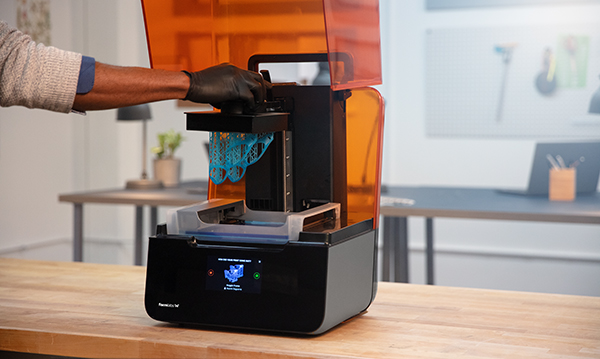Editor’s Pick: Turning SLA printing on its side for improved performance
Formlabs launches two new printers for production workflows.

Formlabs Form 3 places high-quality 3D printing on the desktop. Image courtesy of Formlabs.
Latest News
April 17, 2019
Dear DE reader,
Gillette became a household name by reinventing razors as a personal product instead of a barber’s tool. Today Gillette is reinventing the personal razor again, with a little help from Formlabs 3D printers. The Formlabs Form 2 has become the Gillette workhorse, cranking out custom razors designed online by customers. It is a product and a business model that could only exist in the 3D printing era.
Formlabs has introduced two models in addition to the venerable Form 2, the Form 3 and the Form 3L. They come with a new approach to plastics printing. These new printers—and what Formlabs calls the reinvention of stereolithography—are our Editor’s Pick of the Week.
The big deal here is Low Force Stereolithography (LFS), a refinement of the stereolithography (SLA) lasers-and-resins method. The first Formlabs printers were an instant hit because they were desktop units capable of building parts that could be used for final products, not just prototypes. To make the printer fit on the desktop, Formlabs used an inverted SLA process. They fit on the desktop but also exerted significant forces on the part during printing. Formlabs compensated with heavy calibration but there were still limitations regarding materials and build volumes, and a need for sturdy support structures to print successfully.
LFS completely re-engineers the SLA process, reducing the forces exerted on parts during the print process. It starts with a new optics engine, the Light Processing Unit. The system of lenses and mirrors deliver linear illumination from the high-energy laser, shooting from the Y axis. The light is directed by folded and parabolic mirrors to deliver the beam perpendicular to the horizontal build plane.
Formlabs says the redesign allows for lower print forces inside the build chamber. Lower print forces means light-touch support structures, which Formlabs says tear away with ease during post-processing. The new method allows Formlabs to expand the list of available production-ready materials. SLA printers generally work at higher resolution than fused filament fabrication units. In the Form 2 the laser spot size is 140 microns; in the new Form 3 and Form 3L it is 85 microns. Smaller spot size means smoother parts and finer details.
The new Form 3 and Form 3L are designed for constant uptime. Sensors throughout the machine detect and maintain ideal print conditions. It even knows to send alerts when the printer needs attention. There is considerable modularity to the design of these new models. The Light Processing Unit, resin tank, rollers and optical window are user-replaceable. Both new models use the same print cartridges as the Form 2, offering the existing library of more than 20 specialized and general purpose materials.
3D printing requires a well-engineered interaction between hardware, controlling software, and the materials used to create parts. Formlabs pays attention to all three. New software is included with the Form 3 and Form 3L. RemotePrint allows starting prints remotely; PreForm organizes the print queue; Dashboard manages teams and permissions. All are available for Windows and Mac.
Formlabs has proven themselves in the marketplace—more than 50,000 Form 2 printers have been shipped. We think this next generation will be well received.
Thanks for reading. See you next week with another Editor’s Pick of the Week.
More Formlabs Coverage
Subscribe to our FREE magazine, FREE email newsletters or both!
Latest News
About the Author
DE’s editors contribute news and new product announcements to Digital Engineering.
Press releases may be sent to them via [email protected].






